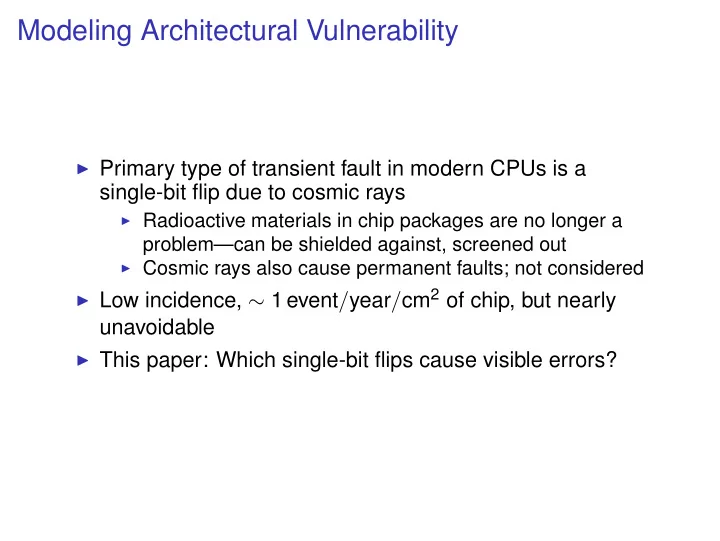

Modeling Architectural Vulnerability ◮ Primary type of transient fault in modern CPUs is a single-bit flip due to cosmic rays ◮ Radioactive materials in chip packages are no longer a problem—can be shielded against, screened out ◮ Cosmic rays also cause permanent faults; not considered ◮ Low incidence, ∼ 1 event / year / cm 2 of chip, but nearly unavoidable ◮ This paper: Which single-bit flips cause visible errors?
Digression: Cosmic rays ◮ High-energy subatomic particles that hit the earth ◮ Ultimately caused by things out in space, like the sun ◮ At sea level, 97% neutrons, 10 5 neutrons / cm 2 / year ◮ Neutrons must hit an atomic nucleus to have any effect J. F. Ziegler (1996) “Terrestrial cosmic rays.” IBM Journal of Research and Development, 4(1) 19–40.
Digression: Cosmic rays ◮ High-energy subatomic particles that hit the earth ◮ Ultimately caused by things out in space, like the sun ◮ At sea level, 97% neutrons, 10 5 neutrons / cm 2 / year ◮ Neutrons must hit an atomic nucleus to have any effect ◮ Crude model of a chip as a sheet of silicon atoms, 1 micron thick ◮ Only one in 240,000 neutrons hits a nucleus. . . ◮ . . . but every hit causes a bit flip ◮ Some variation with circuitry: CMOS less sensitive than bipolar, DRAM less sensitive than logic J. F. Ziegler (1996) “Terrestrial cosmic rays.” IBM Journal of Research and Development, 4(1) 19–40.
Categorizing single-bit flips ◮ An ACE bit is a bit that will affect the outcome of the calculation ◮ An un-ACE bit is a bit that won’t ◮ If we only care about the final outcome, many bits are un-ACE
Categorizing single-bit flips ◮ An ACE bit is a bit that will affect the outcome of the calculation ◮ An un-ACE bit is a bit that won’t ◮ If we only care about the final outcome, many bits are un-ACE ◮ Microarchitectural un-ACE bits: ◮ Idle circuits (unused cache lines, etc) ◮ Mis-speculated instructions ◮ Predictor state ◮ Dead values
Categorizing single-bit flips ◮ An ACE bit is a bit that will affect the outcome of the calculation ◮ An un-ACE bit is a bit that won’t ◮ If we only care about the final outcome, many bits are un-ACE ◮ Microarchitectural un-ACE bits: ◮ Idle circuits (unused cache lines, etc) ◮ Mis-speculated instructions ◮ Predictor state ◮ Dead values ◮ Architectural un-ACE bits: ◮ NOP , prefetch, hint instructions (all fields but opcode) ◮ Predicated-false instructions ◮ Dynamically dead instructions ◮ Masked bits (e.g. or-ed with zero)
The architectural vulnerability factor ◮ AVF of a bit = probability of a visible error if that bit flips ◮ Equal to fraction of execution time that bit is ACE ◮ AVF of a structure is just average AVF of all its bits ◮ Can also be computed as bandwidth-latency product of ACE bits through that structure ◮ This allows use of a performance model (e.g. a cycle accurate simulator) to estimate AVF
Example: instruction queue ◮ ∼ 100 bits per entry in IA64 instruction queue ◮ 25 bits always ACE (5 control, 7 opcode, 6 predicate, 7 dest register) ◮ Other 75 bits assumed ACE iff instruction is ACE ◮ For SPEC2000, average 45% ACE instructions ◮ Largest categories of un-ACE instructions: NOPs (26%), dynamically dead (19.6%), prediated false (6.7%) ◮ Works out to 28% AVF for instruction queue bits
Advantages ◮ Identifies vulnerable structures (high AVF) ◮ Also identifies underutilized structures (low AVF) ◮ Consistent with particle bombardment experiments ◮ Consistent with statistical fault injection ◮ Easier than either ◮ Needs only a performance model—can be done early ◮ Requires fewer experiments ◮ Gives breakdown of why bits do not affect results
Disadvantages ◮ Does not model permanent faults ◮ Also caused by particle strikes (at much lower rates) ◮ Many other causes, more common (electromigration, thermal cycling) ◮ Actual incidence of bit flips is ignored ◮ If you’re going to worry about bit flips you have to do that ◮ But often “don’t worry about it” is fine ◮ Using benchmarks to tune correctness ◮ True of any statistical error study—only as good as its sample
Recommend
More recommend